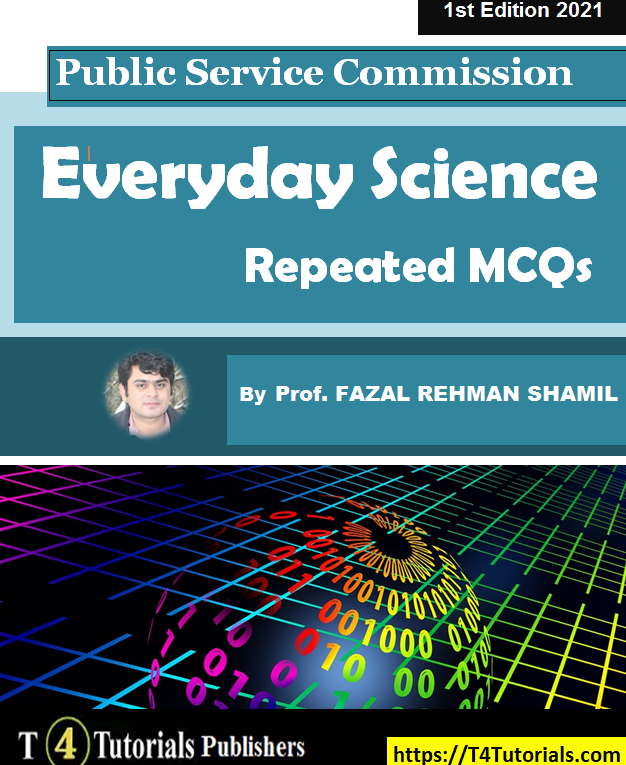Everyday Science Multiple Choice Questions
1. Angstrom is a unit of quantity … A. Heat B. Length C. Force D. None 2. Entomology is the study of? A Behavior of human beings B Insects C The formation of rocks D The Origin and history of technical and scientific terms 3. Fathom is the unit of measurement of….? A Depth of water B Density of water C Volume of water D Flow of water 4. …………….. measures the temperature, pressure, and humidity at various altitudes in the atmosphere is? A. Aneroid barometer B. Barograph C. Radiosonde D. Altimeter 5. All of the following diseases are caused by viruses, except? A. Jaundice B. Influenza C. Mumps D. Typhoid 6. The species that flower is named? A. Angiosperms B. Bryophytes C. Algae D. None of these 7. ……….. converts the alternating current into direct current? A. Dynamo B. Rectifier C. Transformer D. Transducer 8. Are basidiospores major source of …. ? A. Water Borne Allergens B. Airborne Allergens C. Animal Faeces D. All of these 9. Physiology is the study of…? A Cells in the body B Structure of the body C Functions of the human body D All of the above 10. Can the sunlight reach a depth of following meters? A. 80 B. 100 C. 444 D. None 11. The weight of a Heart of a normal adult human being is? A. 100 grams B. 250 grams C. 300 grams D. 400 grams 12. In a normal human adult, how much blood does the heart pump per minute? A. 1 litre B. 8 litre C. 7 litre D. 5 litre Which vitamin does the Carrot have? (A). Vitamin A (B). Vitamin B (C). Vitamin C (D). Vitamin D (E). None of these Multiple Choice Question Answer: AWhat Deficiency causes loss of appetite and poor growth? (A). zinc (B). iodine (C). copper (C). iron (E). None of these Multiple Choice Question Answer: A
What do we study in Meteorology? (A). Seasons (B). Atmosphere (C). Air and sounds (D). Winds and clouds (E). None of these Multiple Choice Question Answer: B
What is the volumes of Carbon Dioxide that are in the atmosphere? (A). 0.039% (B). 3.9% (C). 13% (D). 30% (E). None of these Multiple Choice Question Answer: A
Which of the following is essential for the proper formation of teeth? (A). iodine (B). copper (C). fluorine (D). iron (E). None of these Multiple Choice Question Answer: C
What is the allotropic form of Diamond? (A). Carbon (B). Hydrogen (C). Nitrogen (D). Silicon (E). None of these Multiple Choice Question Answer: A
What is the SI unit of Heat? (A). Watt (B). Volt (C). Joule (D). Newton (E). None of these Multiple Choice Question Answer: C
Which of the following are the good sources of Vitamin-A? (A). green leafy vegetables (B). seeds (C). fresh vegetables and fruits (D). sea-foods (E). None of these Multiple Choice Question Answer: A
Which of the following are The good sources of Vitamin-C? (A). green leafy vegetables (B). seeds (C). fresh vegetables and fruits (D). sea-foods (E). None of these Multiple Choice Question Answer: C
Which of the following are the good sources of iodine? (A). green leafy vegetables (B). seeds (C). fresh vegetables and fruits (D). sea-foods (E). None of these Multiple Choice Question Answer: D
Which of the following is the gas, commonly known as “laughing gas”? (A). Carbon Dioxide (B). Sulfur Dioxide (C). Nitrous Oxide (D). Sodium Oxide (E). None of these Multiple Choice Question Answer: C
Which of the following is the source of oxygen in photosynthesis? (A). water (B). salts (C). minerals (D). glucose (E). None of these Multiple Choice Question Answer: A
Which of the following is the instrument used to measure wind speed? (A). Anemometer (B). Barometer (C). Hydrometer (D). Hygrometer (E). None of these Multiple Choice Question Answer: A
About how many billion years ago the Universe began, According to the Big Bang Theory? (A). 10 – 20 (B). 5 – 10 (C). 30 – 40 (D). 40 – 50 (E). None of these Multiple Choice Question Answer: A
Which of the following are the good sources of Vitamin-B Complex? (A). green leafy vegetables (B). seeds (C). fresh vegetables and fruits (D). sea foods (E). None of these Multiple Choice Question Answer: B
To measure what do we the Biosensor? (A). Blood glucose level (B). The body pH value (C). Amount of hemoglobin (D). Salinity in Urine (E). None of these Multiple Choice Question Answer: A
In what the digestion of food is completed? (A). small intestine (B). large intestine (C). stomach (D). Liver (E). None of these Multiple Choice Question Answer: A Read More MCQs of everyday Science
- Everyday Science MCQs
- Everyday Science Multiple Choice Questions
- Everyday Science MCQs pdf
- Everyday Science MCQs with Answers
- Everyday Science MCQs PPSC
- Everyday Science MCQs FPSC
- Everyday Science MCQs Past Papers
- NTS Everyday Science MCQs
- Important MCQs Everyday Science
- 10,000+ General Knowledge MCQs
